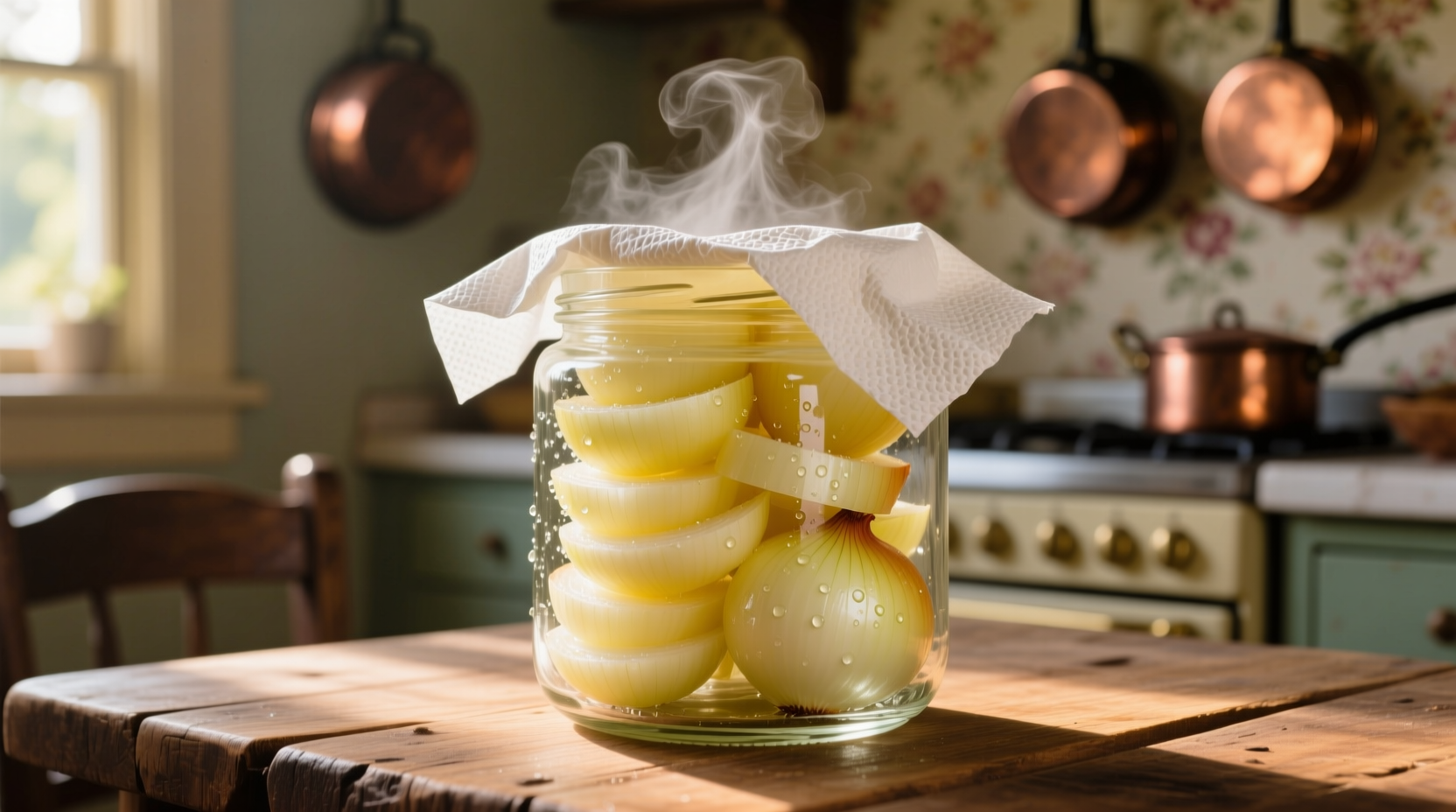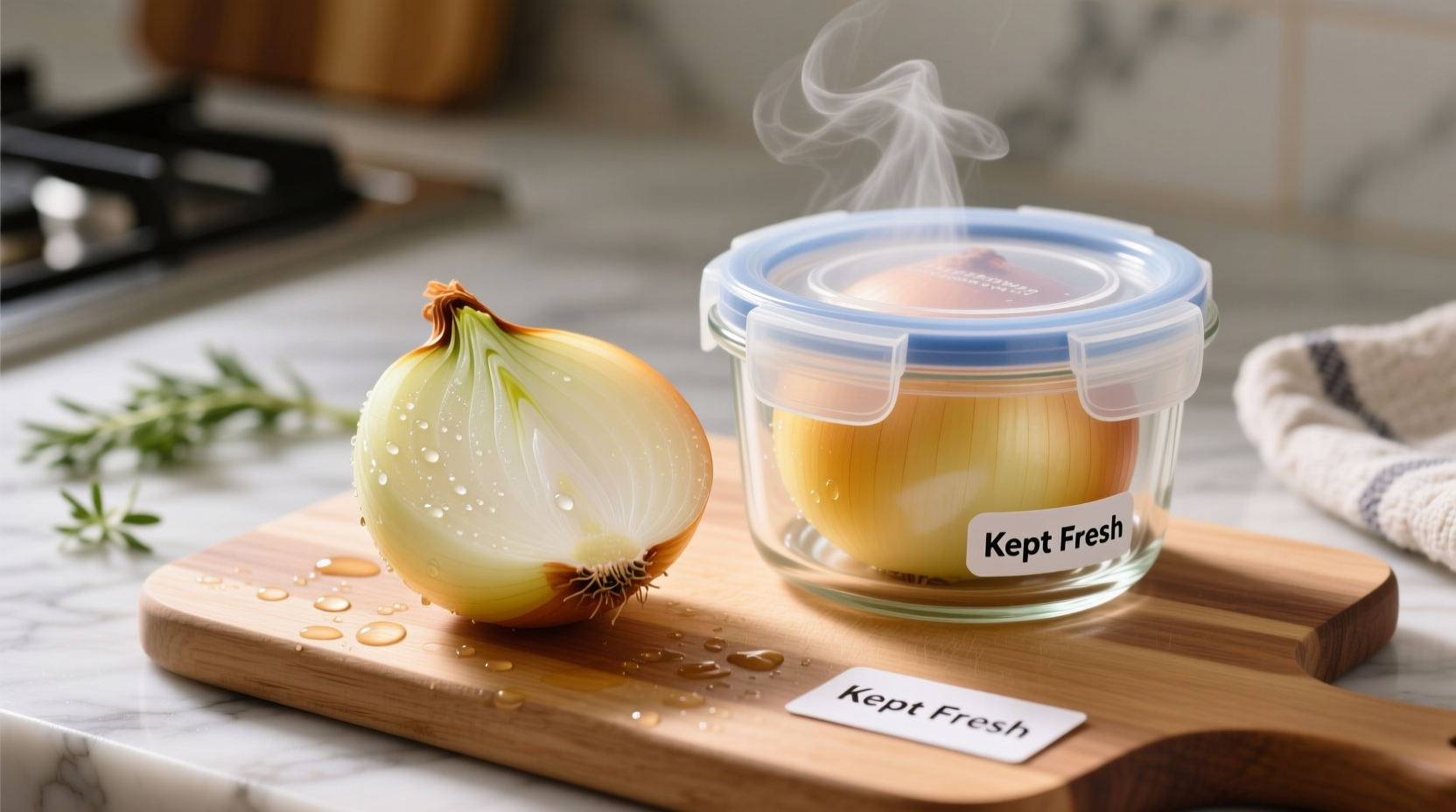Nothing ruins meal prep faster than discovering your half-used onion has turned slimy or developed an off smell. As a professional chef who's worked in high-volume kitchens, I've seen countless home cooks struggle with this common kitchen problem. The good news? Proper storage extends your cut onion's life significantly while preserving its flavor and texture.
Why Cut Onions Spoil So Quickly
When you cut an onion, you break its cell walls, releasing enzymes that cause oxidation and moisture loss. This enzymatic reaction accelerates spoilage, making cut onions particularly vulnerable compared to their whole counterparts. The USDA confirms that cut produce generally has a much shorter shelf life due to increased surface area exposed to air and bacteria.
Step-by-Step Guide to Perfect Onion Storage
Follow these professional kitchen-tested steps to maximize your cut onion's freshness:
- Prep properly: After cutting, gently pat onion pieces dry with a clean paper towel to remove surface moisture
- Select the right container: Use glass or BPA-free plastic containers with tight-fitting lids (avoid containers with visible cracks)
- Control moisture: Place a fresh paper towel at the bottom of the container before adding onions
- Store correctly: Place container in the main compartment of your refrigerator (not the door), ideally at 34-40°F (1-4°C)
- Check regularly: Replace the paper towel if it becomes saturated to maintain optimal dryness

Comparing Different Storage Methods
| Storage Method | Shelf Life | Flavor Preservation | Best For |
|---|---|---|---|
| Airtight container + paper towel | 5-7 days | Excellent | Daily cooking needs |
| Plastic wrap directly on surface | 3-4 days | Good | Short-term use |
| Submerged in water | 2-3 days | Fair (mild flavor loss) | Raw applications only |
| Freezer (diced) | 3-6 months | Good for cooked dishes | Long-term storage |
According to research from the University of California Davis Postharvest Technology Center, the airtight container method with moisture absorption works best because it addresses both oxygen exposure and humidity control—the two primary factors in onion deterioration. Their studies show that maintaining relative humidity between 65-70% significantly extends freshness compared to standard refrigerator conditions.
When Not to Use Stored Onions
Food safety should always come first. Discard cut onions that show any of these warning signs:
- Visible mold or fuzzy growth
- Slippery or slimy texture
- Unpleasant sour or ammonia-like odor
- Significant discoloration (yellowing or dark spots)
The FDA Food Code specifies that ready-to-eat, potentially hazardous food (like cut produce) should be discarded after 7 days when stored at proper refrigeration temperatures. While onions might appear fine beyond this point, the risk of bacterial growth increases significantly.
Pro Tips for Maximum Freshness
Professional kitchens use these additional techniques to extend onion shelf life:
- Store cut onions away from ethylene-producing fruits like apples and bananas
- Keep different onion varieties separate (sweet onions spoil faster than yellow onions)
- For meal prep, cut onions into uniform sizes for consistent storage
- Never store cut onions near strong-smelling foods—they readily absorb odors
Remember that storage duration varies by onion type. As noted in the Journal of Food Science, yellow onions maintain quality longer than sweet varieties when cut. Vidalia and Walla Walla onions typically last only 3-4 days refrigerated after cutting, while standard yellow onions can reach the full 7-day window with proper storage.
Frequently Asked Questions
Can you freeze cut onions for long-term storage?
Yes, freezing is excellent for long-term storage. Chop onions to your desired size, spread in a single layer on a baking sheet, freeze until solid, then transfer to airtight freezer bags. Properly frozen onions maintain quality for 3-6 months and work well in cooked dishes, though they'll be too soft for raw applications after thawing.
Why does my stored onion taste different after a few days?
Cut onions undergo chemical changes that can intensify their flavor over time. The enzyme alliinase continues reacting after cutting, creating stronger sulfur compounds. This is why stored onions often taste sharper. Using them in cooked dishes minimizes this effect, as heat deactivates these enzymes.
Is it safe to store cut onions at room temperature?
No, the USDA Food Safety and Inspection Service recommends refrigerating cut onions within two hours of preparation. At room temperature, cut onions enter the 'danger zone' (40-140°F) where bacteria multiply rapidly. Even in cooler kitchens, room temperature storage should never exceed 2 hours for food safety reasons.
Can I store different cut vegetables together with onions?
It's not recommended. Onions emit sulfur compounds that can transfer flavors to other vegetables, particularly delicate ones like leafy greens. Additionally, different vegetables have optimal humidity requirements—onions need drier conditions than most produce. For best results, store cut onions separately in their own container.











 浙公网安备
33010002000092号
浙公网安备
33010002000092号 浙B2-20120091-4
浙B2-20120091-4